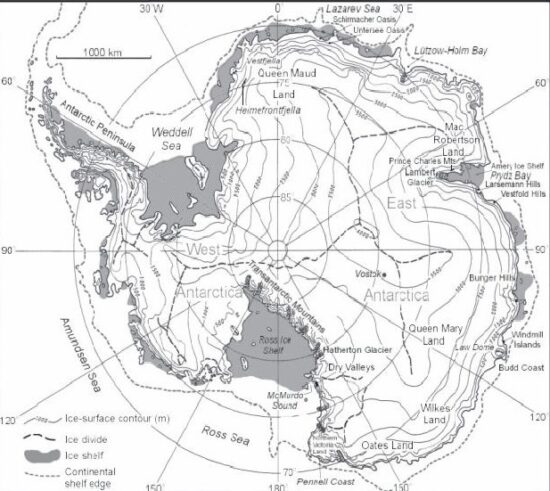Modelling future ice sheet behaviour has researchers studying previous retreats in Antarctica. A recently published paper appearing in Nature Communications is entitled Decadal-scale onset and termination of Antarctic ice-mass loss during the last deglaciation. It identifies up to eight ice retreats that occurred after the Last Glacial Maximum when Antarctica’s continental ice dome was up to 600 metres greater in height than today and the extent of ice shelves was significantly greater. During one of those deglaciation episodes, the Ross Sea ice shelf retreated 400 kilometres (almost 250 miles).
The study noted another characteristic of the ice sheet behaviour, the speed at which destabilization and restabilization occurred in the past. Instead of centuries or millennia, the changes happened in decades.
The authors of the study are a team of researchers from the United Kingdom, Australia, and New Zealand. They note the difficulty in deciphering what happened to sea levels during interglacial periods during the Ice Age, known as the Pleistocene. This most recent cooldown dates back approximately 1.85 million years. Some climatologists believe the Ice Age is still with us and what we are experiencing is an interglacial warming period that started 11,500 and 10,000 years ago. Without anthropogenic global warming, some have speculated that we would experience a new glacial episode in the not too distant future with we being the distinguishing factor. It is our behaviour in moving from hunter-gatherers to farmers and urban dwellers that have altered the landscape in an unprecedented fashion and filled the planet’s atmosphere with industrial warming pollutants.
What this means for Antarctica’s two massive ice sheets, the largest remaining repositories of continental ice on Earth, remains unknown. Referred to as the East and West Antarctic Ice Sheets, the latter rests on bedrock 3.4 metres (over 11 feet) below current sea levels. If it were to melt in its entirety it would raise global sea levels 4.3 metres (over 14 feet). A portion of the East is also exposed to marine instability although the majority lies on bedrock above sea level. Were the marine portion to melt it would contribute 3 to 4 metres (approximately 10 to 14 feet) of additional sea-level rise.
Studying the deglaciation in Antarctica from 19,000 to 8,000 years ago shows the contribution of the retreat of the two continental ice sheets to their current positions and thickness. That deglaciation contributed to a sea-level rise of 16 metres. It didn’t happen at once, but rather in a series of distinct pulses lasting over several centuries.
The paper mentioned above involved studying Iceberg Alley and the calving of ice from the ice shelves and Antarctic margins. Well documented, it shows from iceberg data, that the transition from low to high counts and calving is rapid, indicating deglaciation episodes could be decades-long or less with substantial short-term impacts on sea levels. The reverse is true as well with glaciation just as rapid.
In addition, to understand the impact of future deglaciations, the paper describes the geological and climatological record of recent interglacial warming. Where there may be differences in predicting a future course for the two Antarctic ice sheets comes from understanding the environmental dynamics of interglacial deglaciations which include:
- the warming of the subsurface ocean.
- the increasing warming of the atmosphere.
- the coincident deglaciation in the Northern Hemisphere leading to rising sea levels further eroding the underside of the ice shelves and continental margins.
- the influx of freshwater melt from continental ice sheet melt.
- the transfer of heat from the Atlantic meridional overturning circulation from the Northern to Southern Hemisphere.
Current modelling, without these other dynamics, suggests surface waters of the Southern Ocean abutting the two ice sheets will warm sufficiently to cause sea levels to from 10 centimetres (0.3 feet) to one metre (3.3 feet) by 2100, and up to 16 metres (52 feet) by 2500. The more extreme modelling assumes no mitigation action on our part to reverse global warming.
















